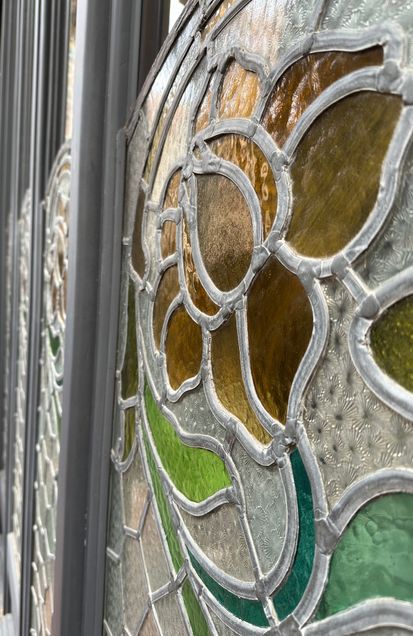March 12. The Palau Experience
By Brian Beck
The artificial garden set among a previous industrial backdrop was the treat for today. The Palau de la Música Catalana stands unapologetically in its location as a bastion for all forms of music. However, if you happen to be a musician, don’t let its warm atmosphere fool you. We were told this is a place of quality, and to be accepted onto its stage means standing where legends have let their sound wash over captivated audiences. With all of the Muses watching from above the stage, the feeling of performing there must be intoxicating.

The building itself looks as if it is dying to make a sound. With many stained-glass windows, columns adorned with vines, transparent glass pillars supporting the stairs, and a ceiling that forms into a colorful teardrop, the Palau reminds me of a sea glass wind chime. I imagine the slightest breeze through the area would make it come alive. It is a Catalan treasure that is constantly transforming itself and adapting to the future. From the hidden orchestra pit to a new donor-funded organ that can be accessed remotely, the Palau continues to adapt to an ever-changing medium without losing its individuality and style.
What interested me the most was that this was a place built from philanthropy before philanthropy was even a business. In Spain, we continue to see that the driving force in making locations like these a reality is a force of devotion and love. It was a palace built for a choir, and it was built with no compromises. Being entirely privately funded has a way of cementing something in a community, and now it’s time for the Palau to engage that community once again. As with many organizations in the U.S., the Palau’s donor base is aging. I believe 70-75 was the average age of the Palau’s regular donor base. They know that they need to capitalize on the younger generation and begin growing their lifelong relationship with the Palau. I was happy to hear Nùria constantly referring to relationship building as the primary focus, as this is as by the book as you can go. She knows her constituency and that her approach is solid. I can tell if someone else was in her role they may try to pivot from this too soon as it can take a long time to begin to see results. With very little time in her role, she has already drafted a strategic plan and plans to start executing within the year. I fear for her team of two as more fundraising responsibilities start to pile up and as the budgets begin to rise. There are only so many donors that one can meet with and so many hours in the day.
Wonderful advice was offered from the class, especially concerning the younger donor giving society at 500 euros, effectively a young professionals group. I was shocked that having 7,000 members was not a pleasing statistic to Nùria, as I think this is a fantastic start to a giving society.  The Palau is also a treasure to the government and can always count on that 18% of funding to build from, and with proper donor relations, organization growth, and detailed reporting, they may be able to sway that percentage more in their favor.
The Palau is also a treasure to the government and can always count on that 18% of funding to build from, and with proper donor relations, organization growth, and detailed reporting, they may be able to sway that percentage more in their favor.
We can also see the Spanish cause and effect-based fundraising model as Nùria explained how they want to relay what the donor dollars are going toward. This is something U.S. development staff is still fighting with the finance team about. I wonder how easy it is for the Palau to track its spending. The only thing I did not agree with was the transactional approach of asking for donations after tours. You may earn some revenue, but it can be off-putting, especially if it is the individual’s first time at the Palau. I think a more effective way would be through annual fund work with donors. You can roll the 2-million-euro maintenance budget into this fund, as well. If you have donations taken in-house, it would be better accepted if it was during a project and if it was a passive ask, not a direct one. But I have a feeling that the Palau will continue to surprise us, even on this front.